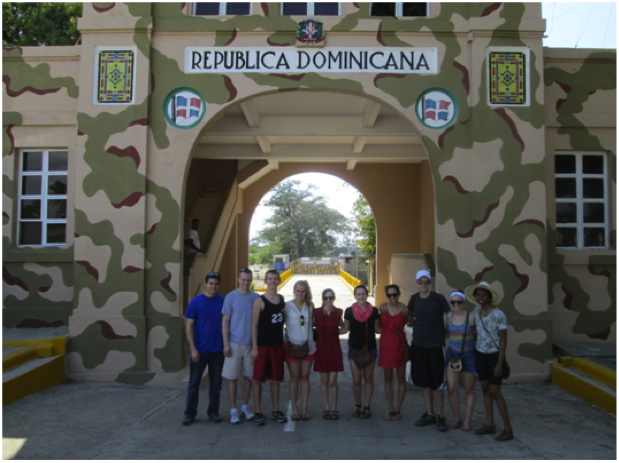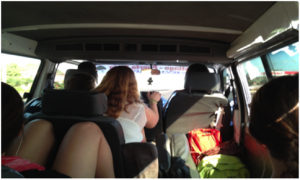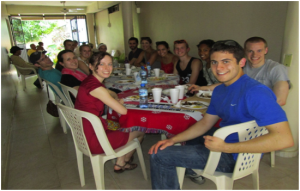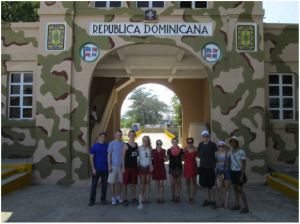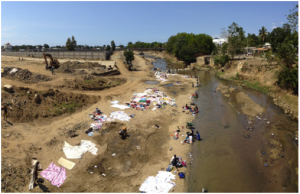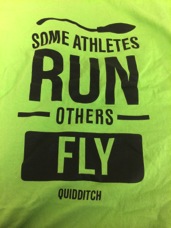~9:30 PM
Our group has just returned to the hotel on Day 2 of the University of Delaware Honors Program UDaB trip and I resist the urge to watch the Indiana Jones film playing on our television. Instead, I reflect on the day and am only vaguely aware of the din of vehicle traffic, speeding motorbikes, and honking drivers that remind me that Santiago nightlife is still active. I ignore the impulse to look out my window and start to remember how the day began and our van trip to Dajabón this morning….
~9:15 AM
The van awaits us and our destination is Dajabón, a border town between Haiti and the Dominican Republic. Thirteen of us crowd into the van and it is close quarters, even with the luggage tied to the roof. I remember taking a piece of chicle, or chewing gum, to ward off motion sickness in case there were bumpy roads or traffic along the way. We all had graham cracker provisions because the trip would take a few hours and would pass by military checkpoints as we neared the border between Haiti and the DR. Once I was situated in the van, my view was restricted to backpacks, fellow passengers, and the bobbing of the tree-shaped air freshener the van driver had wisely affixed to the rearview mirror. Looking out the van window, I was entertained with a picturesque mountain landscape, wide open fields and clear skies.

The view from my window seat. As we drove we saw green pastures and fields give way to a more arid landscape.
Sometime that afternoon:
After a brief stop in Esperanza to drop off our luggage, we finally reached Dajabón. Once there, we checked into our hotel, put on a preemptive layer of picaridin bug spray to deter the wildlife and headed over to Dona Pura’s for lunch. We collectively devoured a variety of chicken, rice and vegetable dishes, and enjoyed homemade pineapple and orange juices – as well as a drink called “avena” that tasted like Creamsicles! After the long van trip we were all eager to walk around and stretch, so after eating, we walked toward the “old” border.
As we walked, we felt the warm tropical heat and stopped to sample ice pops sold by two boys traveling through the streets with their coolers. Upon reaching the arch of the Dominican military station, we had our first view of Haiti peeking through the camouflaged-style painted archway. Passing through the arch and walking out onto the border bridge, we were soon deterred by barbed wire and a padlocked gate.
However, it was the view to the sides of the bridge that had the most impact on me. Along the banks of a slow flowing river, groups of women were washing clothes, children were splashing in the water and numerous garments were left on bare dirt and rock to dry. I was struck by the contrast between what I had seen in the DR and what I was now seeing in Haiti. The Haitians appeared to lack resources and basic services while the Dominicans seemed to be more affluent. When the Haitian children and the occasional adult looked up at us, I felt uncomfortable seeing their poverty. Looking back, I realize now that while there was a physical gap between my group on the bridge and the locals below us, the gulf between our experiences and struggles was far wider. As an outsider looking in, I could only imagine what their lives were like and found it difficult to comprehend their struggles. As I watched trash float in the river and animals wade through the same water that people were using to wash their clothing, I was aware of how much I take for granted living in the United States. Furthermore, I began to think about what responsibility the United States and other wealthy nations have to assist struggling countries such as Haiti.
- To the left and right of the gate we could see Haitian children playing in the water, people swimming, and women washing clothes.
Seeing the border between the Dominican Republic and Haiti also made me begin to question things. Why was the bridge so heavily fortified when the border below was a shallow river with only sparse vegetation? Where did the Haitian people actually live? Why couldn’t these people locate a more desirable water source? I struggled to fathom their daily experiences and despite my pictures and notes from the bridge, later that day I still couldn’t believe what I had seen.
After the visit to the “old” border bridge, we traveled to the “new” border. This was an entirely different atmosphere, where we saw the bustle of commerce as people crossed the border with their wares in both directions. With the help of our guides, we began to notice the inequities that existed at the border. For instance, on the road deck of the bridge, we saw concrete deposited in rectangular grids. We soon learned that this was a Dominican government directive that these rectangles be filled with bleach to form pools of disinfectant on the bridge’s surface. The rationale behind this was so that when the Haitians came to do business in the Dominican Republic, they would be forced to walk through this bleach – ostensibly to prevent the spread of cholera. Since there is no scientific basis to prevent cholera in this manner, this practice provided insight into the skewed power dynamics on the island. Likewise, as we stood at the border, we actually witnessed Haitians being deported. A pickup truck on the Dominican side of the border slowed as it approached the bridge and then the guards at the border opened the gate and escorted the men out of the truck and towards the gate. I was shocked by the size of the group and how the deportation began and ended in mere moments. This made me think of the articles we had read before the trip and I contemplated if this scene would become more familiar if recent Dominican immigration rulings are enforced.
Now that Day 2 of the trip is over, I realize that this UDaB trip will teach me more about the island, its people, and their history than I ever expected. Having seen first-hand the realities of life for those on the border, I now have a better sense of the struggles they face and the obstacles of their everyday lives. My desire to help and volunteer on the island has been strengthened and I expect that today’s itinerary will be one of the most memorable parts of the trip. Looking back, I am beginning to understand that this border journey will continue to shape my perspective long after I cross the U.S. border and return home.
~Tim D’Agostino, 2016

